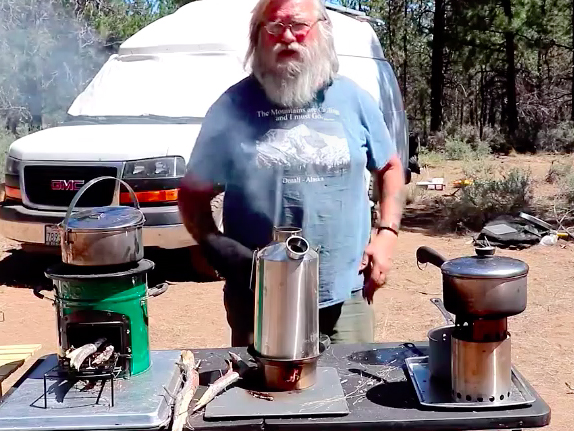How Can We Help?
Compact wood stove comparison
“Usefulness, for me, is just as important as speed.”

Today we’ll compare three wood stoves. All are variations on the rocket stove design. When cooking on an ordinary open flame or over coals, a portion of the heat escapes around the sides of your pot or pan. But with rocket stoves the heat is enclosed in what is essentially a double-walled chimney. Rising hot air draws in fresh air at the bottom of the stove, stoking the fire and creating a hotter flame, which draws in even more fresh air, which stokes the fire further. You can create a very hot fire from a minimum of wood. A couple of handfuls of twigs and sticks are often enough to cook a meal. In some cases, charcoal or other biomass fuels may also be used.

The StoveTec Big Foot is the more conventional design of our three samples. Wood — from twigs to good sized sticks — is fed in through a side opening. The stove’s diameter-to-height ratio makes it very stable, and it’s wide enough to handle most cookware. However StoveTec also offers a pot especially sized and shaped to maximize the stove’s efficiency.
(The StoveTec Big Foot is no longer available new. The EcoZoom Dura is nearly identical.)
The Kelly Kettle Camp Stove employs a unique twist on the basic rocket stove. Whereas other stoves have insulation — or nothing — between the inner and outer walls of the stove, the Kelly Kettle has a water jacket and spout, acting like, well, a kettle. And since you can also have a pot on top, you could cook another dish while heating water, although there would be a bit of a juggling act if you needed hot water while still cooking something. The Kelly Kettle is rather tall, so you’d need to be good at keeping things square and balanced. Wood can be added either through a hole in the base or down the “chimney.”
The Solo Stove Titan is the middle of three sizes offered by the company. It, too, has a unique twist. It has an alcohol burner you could use instead of wood. This is handy if you’re in an area with very little wood, like the desert, or if the weather (and therefore the wood) is wet. Solo Stoves feed wood from the top via a gap in the ring that supports either your pan or the special pot the stove packs into.
Which stove cooks faster?
In our unscientific test, the Kelly Kettle boiled two cups of water in two minutes, the Solo Stove in five minutes, and the StoveTec in seven minutes. But that’s really just a test of maximum heat and the surface area of the pot — or the water jacket in the case of the Kelly Kettle. How would they perform cooking a meal? That would require testing we’re not equipped to do.
Advantages of rocket style wood stoves:
• Free fuel
• More efficient than open fires
• Less smoky than open fires
• No worries about pressurized fuels
Disadvantages of wood stoves:
• Must be used outside
• Need to be on a nonflammable, heat-resistant surface
• Can’t be used where there’s a fire ban (except with the alcohol option)
• Cookware can get sooty
• A learning curve on temperature control
Which wood stove is right for you?
Assuming the benefits of a wood stove outweigh the disadvantages for you, it still depends on what your cooking goals are. If you primarily need hot water fast for coffee, tea or dehydrated foods, then the Kelly Kettle is probably your choice. If you need something more compact and with the option to use alcohol, then the Solo Stove will likely suit you better. If you tend to cook dishes that require more temperature control or long cooking times, the StoveTec, with its ability to handle thicker, longer burning sticks, might be the good choice.
Which stove did Bob prefer?
“I would say the StoveTec Big Foot is, by far, the more enjoyable experience. If I were tent camping or car camping, and I could just set it up, get a fire going, and put a couple of gallons of water on it and leave it going all day, then I’d have hot water all day for just a few sticks. I think this is a realistic use of your time.
“The Solo is a great stove because of its size, its cost, and dual fuel capability.
“And the Kelly Kettle is, by far, the fastest and most efficient, with the most heat for the least amount of wood. But, to me, it’s kind of a pain in the butt. Usefulness, for me, is just as important as speed.”
